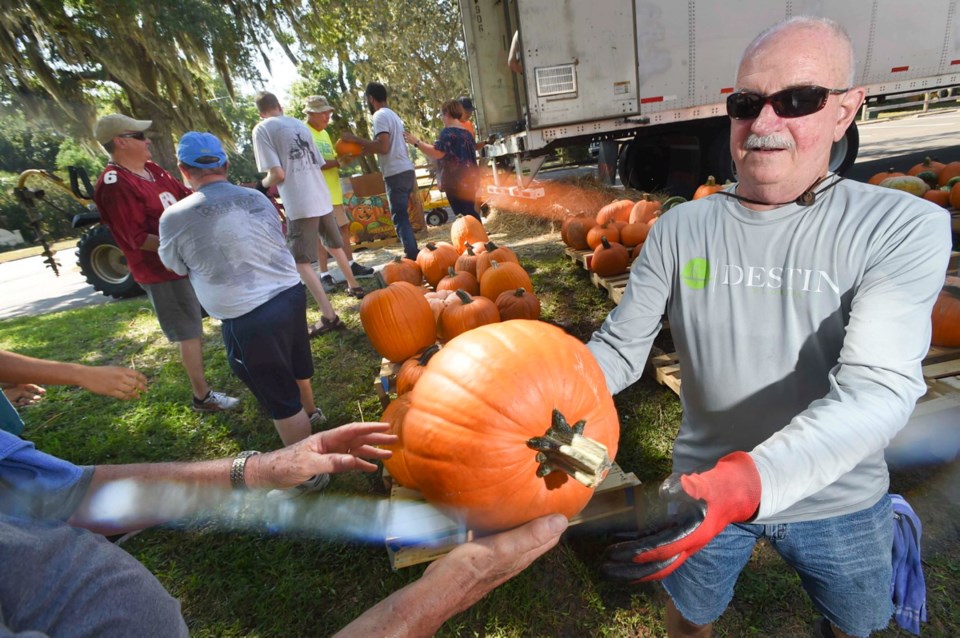We might enjoy pumpkin pie and zucchini frittata only because massive, hairy animals went extinct at the end of the Ice Ages.
Pumpkins, zucchinis and other squashes belong to a family of plants called cucurbits, which also includes gourds, cucumbers and melons. Wild gourd and squash seeds found in fossilized dung indicate that large, ancient herbivores such as mastodons, mammoths and giant sloths ate the fruits’ ancestors, then spread them by pooping out the seeds.
When anthropologists compared the ranges of modern domestic cucurbits, modern wild cucurbits and fossil specimens of the large planteaters across Central and southern North America, they found the wild varieties provide a rough map of where the animals lived about 12,000 years ago.
And when the researchers examined animals’ taste receptors, they found that, compared with large animals with a limited diet, smaller animals with diverse diets possess many more bitter taste receptors on their tongues. That means, delicate humans and the like are more sensitive to “bitter” than mammoths, mastodons and their modern-day counterparts are.
This is important in the pumpkin story, because wild species of the pumpkin family, as well as a few domesticated varieties, can produce a group of bitter-tasting chemicals known as cucurbitacins. If you’ve ever had the bitter melon on offer in the food court at Richmond’s Yaohan shopping centre, you’ll know that it is, indeed, bitter.
Cucurbitacins can also be poisonous to humans.
Scientists now think that humans only took pumpkins on as a project after Ice Age animals left the scene. Genetic analysis of 91 pumpkin and squash species suggests early North Americans domesticated the plants several times.
The first instances may not have been for food. Anthropologists argue that early North Americans viewed early, wild species of pumpkin, squash and related fruits as containers, fishnet floats and other tools.
However, during domestication, tasty pumpkins and squashes emerged, ensuring the future of Thanksgiving feasts. Farmers started selecting the fruits for taste and grew more varieties that met their flavour requirements. They allowed most other, less useful, varieties to disappear.
But it’s not so easy to purge the wild gourd. Every living organism’s blueprint is contained in its chromosomes. Made up of DNA and protein, chromosomes contain genes and come in pairs. One half of each pair comes from a organism’s mother; the other half from its father.
In human terms, that means my mom and dad each donated 23 chromosomes to create me. The donated chromosomes partnered up, and — voilà — a science geek resulted. (As a human, I share 75 per cent of my genome with squashes — in my case, most likely one of the pointy-headed crookneck varieties.)
But pumpkin’s story deviates from that oft-unfolding gene-sharing tale. Sometime between three and twenty million years ago, two individuals from distinct cucurbit species merged their entire blueprints. In a case of kinky plant sex, both parents chipped in their complete chromosomal counts, and — voilà — a new vegetable emerged. It bears two subgenomes instead of the typical one, or four copies of each chromosome instead of the usual, humdrum two.
Since then, genus Cucurbita has randomly lost genes. It now contains just 20 chromosome pairs but still more than its close-relatives watermelon (11 pairs) and cucumber (seven pairs) do.
Despite the opportunity that comes of having four complete chromosomes skinny dipping together within cell nuclei over eons, neither pumpkin parental genome took control. Modern pumpkins and squashes retain much the same chromosome structures donated by First Squash Mother and First Squash Father, and those have acted largely as equal partners over pumpkins’ long history.
Extra and egalitarian chromosomes confer some advantages — namely flexibility. From the great genetic bounty of two subgenomes, hidden traits emerge or re-emerge quickly. For example, farmers today cultivate pumpkins and squashes that produce little to no bitter cucurbitacin chemicals. But if the crops cross-pollinate — something squashes are notorious for doing — the results easily revert to old-timey toxin production, creating potentially toxic, bitter-tasting, inedible fruits.
Two cases of cucurbit poisoning, or toxic squash syndrome, occurred in France in 2017. Symptoms resembled food poisoning — nausea, vomiting, the squirts — with hair loss thrown in. The perpetrators were pumpkins from reverted plants.
Cucurbitacins may not have fazed the massive, hairy gourd-eaters of the last Ice Age, but we owe the tastiness of this weekend’s pumpkin pie to two-legged pumpkin-eaters who bred out the bitterness and the poisons.



